|
The Edwardian age into which The Marconigraph was launched 50 years ago was less prone than is the Neo-Elizabethan to the unquestioning acceptance of scientific marvels. Many people still looked upon wireless telegraphy as 'against Nature'; as something akin to a music-hall trick. That attitude of mind was certainly not discouraged by wire telegraphy and submarine cable interests, with whom we were to remain in bitter competition for many years. By way of counter-attack, we made great play of the fact that the so-called 'KR factor,' which limited the speed of cable transmission, did not apply to us. High-speed wireless transmission - which then meant about 60 words per minute - had already been demonstrated experimentally, but the volume of traffic on offer was generally not great enough to encourage its commercial use.
Whatever the reason may have been, wireless telegraphy had hardly made spectacular progress during the first dozen years of its existence. When we began publication there were, according to official figures published later, a mere 1,740 licensed land and ship stations in the whole world.
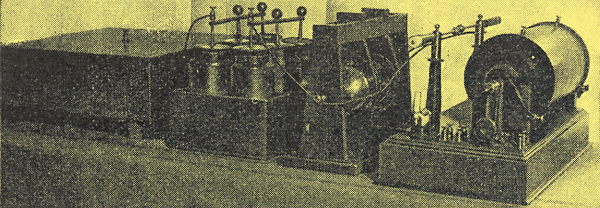
A 'coil set' the kind of transmitter that was going out as Wireless World was coming in.
Right to left: induction coil, spark gap, 'battery' of Leyden jar condensors, 'jigger'
But that understates the position rather seriously. The United States had not ratified the International Convention and had no licensing system; thus the true number of her stations cannot be ascertained. For once, America had made a slow start in taking up a scientific innovation; when the first wireless-equipped ships sailed from Europe to the New World there were no coastal stations in the North American continent with which they could communicate. But America was soon to catch up, and by 1911 probably had a greater number of stations than any other single country. Going by the few figures available and working backwards from the time when licensing came in, it is fairly safe to guess at a round 1,000, or something not far short of it. Thus the world total of stations in 1911 was over 2,500. The total number of people gaining their livelihood in wireless, from Mr Marconi himself down to the humblest messenger boy, could hardly have exceeded 8,000.
Though the commercial growth of wireless may have been disappointingly slow, technical progress had been quite impressive. An old-timer dating back to 1911 might make out some sort of case for claiming that the effectiveness of the gear of his period had increased as much since 1897 as it has done between 1911 and the present day. Be that as it may, he would be on pretty sure grounds in going on to claim that by 1911 the foundations of nearly all modern techniques had been laid and the majority of the great basic inventions had been made. Practitioners of the art certainly did not look on themselves as being in the Dark Ages. They had already seen great technical progress and were full of confidence for the future. To them, it was a kind of Elizabethan age, when everything was bright, new and exciting.
Many of the inventions that had been made were waiting-and some had to wait for many years-for the means to put them usefully into practice. Christian Hillsmeyer's radar pulses, first suggested by him in 1904, had to wait 30 years for the means of generating them and usefully detecting their reflections. Oliver Lodge's moving-coil loudspeaker looks, in the patent specification drawing of 1898, surprisingly like the instrument of today, even if the 'hi-fi' enthusiast would hardly approve of his diaphragm or its suspension. But valve amplifiers capable of working moving-coil speakers did not appear until 20 years later.
Fleming's diode, which we used to call, rather confusingly, an oscillation valve, was already ancient history, and was not especially esteemed as a signal rectifier. De Forest had added a grid in 1907, but his triode had made no impact. Probably fewer than five per cent of our early readers had ever heard of it and there was no mention of triodes in our pages for the first two or three years. The triode remained in obscurity until the discovery of regeneration caused many workers to concentrate their efforts on its improvement. Those efforts were probably triggered off by von Lieben's work on the amplifying triode in 1910-11.
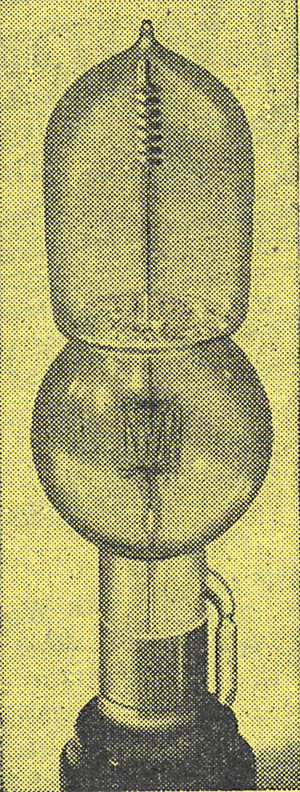
The Leiben-Reisz triode of 1911
Photo: Deutsches Museum, Munich
'Tele-vision' (generally so printed) was a word that appeared surprisingly early. Nipkow had enunciated the basic principles of scanning in the nineteenth century, but few seemed seriously to expect that 'moving pictures by wireless' would be achieved. One of the exceptions was Campbell Swinton, a versatile engineer and wireless enthusiast who had already forecast that, if the difficulties were ever to be overcome, it would be by means of 'the weightless cathode rays' of the Braun tube, the forerunner of the cathode-ray tube of today. Magnetic recording-on wire, not coated tape was already known and had been used for the recording of high-speed signals.
Transistors? Well, hardly. But oscillating crystal circuits had been devised by Dr W H Eccles, one of the 'founder members' of wireless technology whose name recurred constantly in our pages for many years. In another sphere, he was one of the first to accept and interpret Heaviside's theory of a conductive layer in the upper atmosphere as an explanation of observed phenomena in long-distance wave propagation. For a long time to come there was a tendency to ignore or even to scoff at Heaviside's theory; his American co-worker Kennelly had even less recognition on this side of the Atlantic.
In Britain the art we practised was always called 'wireless'. The official international word 'radio' had been introduced some years earlier but had had a chilly reception. It did not trip easily off English tongues; worse, to use it was considered 'non-U' and aping the foreigner. In fact, though, most nationalities still preferred their own versions of 'wireless' sans fil, draktlose, sin kilos. But in Germany they soon began to show a preference for the word Funk (spark) which still survives strongly in Rundfunk (broadcasting).
Naturally enough, wireless had already produced its own jargon. Equally naturally, many of the earlier examples have now disappeared, some of them frozen out by changing techniques. One of the queer words was 'jigger' (RF transformer for coupling the closed circuit, transmitting or receiving, to the open aerial). The derivation of this term is obscure and has apparently been lost in the mists of time. Maurice Child, in a historical lecture in the early 20s, admitted his inability to trace it. 'Billi' is easier; it was a small variable condenser reputed to have a capacitance measured in billionths of a farad. Though by international agreement wavelengths were measured in metres, the foot still served occasionally as the unit. It had not been so long ago that only two wavelengths were in use, officially for merchant ship communication, but in fact for other purposes as well: Tune A, 1,000ft and Tune B, 2,000ft-quite near enough to 300 and 600 metres for the order of accuracy then prevailing. Whether chosen by luck or judgment, Tune B, the more popular, was in fact an excellent general-purpose wavelength for the techniques of the times. The foot (length of wire used in winding a coil) sometimes served also as a unit of inductance!
The Postmaster-General's control of all wireless activities in Britain had been firmly established by the Wireless Telegraphy Act of 1904. Even before that date the Post Office had quietly assumed power over us by virtue of the monopoly in telegraphy conferred on it by Disraeli in Victorian times. This control may at times have seemed somewhat heavy-handed; indeed, Wireless World has on many occasions throughout its life been at odds with the Post Office over allegedly restrictive practices or other departures from rectitude. But we must remember that the Post Office, as one of its historians has said, 'is not just another Department'. It functions under a long-established tradition of providing a public service, first in carrying the mails, then in transmit-ting telegrams and later in running a telephone service. In return, Parliament has granted certain monopolies and privileges, which have always been jealously guarded. Each successive development in wireless must have seemed to the official mind to threaten serious encroachment on these monopolies and it is small wonder there have been occasional bungling and examples of over-cautiousness. However, it is a pleasant thought that Post Office control has generally been benevolent and beneficent.
Apart from the exercise of his monopolistic powers, it was (and is) the duty of the Postmaster-General to ensure the observance of international regulations. In 1911 we were governed by the Convention of 1906, to which nearly all nations had adhered. The United States was an exception; neither had she ratified the Convention (was that a manifestation of the Monroe Doctrine?) nor had Congress as yet passed any law to regulate or control wireless communication. America was indeed the land of the free. But, according to stories-perhaps exaggerated-filtering across the Atlantic, jungle law prevailed. Deliberate jamming of competing stations was commonplace and powerful stations shouted down the weaker. And there was nothing to protect the secrecy of messages. According to the folklore of the time, submarine cable interests intercepted telegrams sent by the Marconi transatlantic station at Glace Bay, Nova Scotia, and published a selection of them - reputedly the most scandalous - as advertisements in New York newspapers. They are also said to have published intercepted messages relating to interruptions in communication, such as 'stand by for three hours; atmospherics too bad', thus hoping further to discourage potential users of the new and then struggling wireless service. This latter kind of interception was eventually circumvented by the use of code words for inter-station messages relating to interruptions and similar matters.
Some support for the truth of these stories comes from the fact that American legislation, when it eventually came, was not particularly onerous in most respects but imposed severe penalties for deliberate jamming and failure to observe secrecy. As things turned out, the American free-for-all had worked remarkably well in the early stages. No doubt most of the stations did in fact establish a tacit modus vivendi with their competitors. But control was bound to come sooner or later; in the event, it came sooner than expected, and for a reason that nobody could have foreseen.
Wireless telephony had already been accomplished experimentally when we began publication, but was as yet of no practical significance. Both arc transmitters and rotary RF generators capable of producing continuous waves had -been developed, but in the absence of valves the problem of modulation was indeed difficult. Water-cooled and liquid jet microphones, inserted directly in the aerial circuit had been used in some of the experiments.
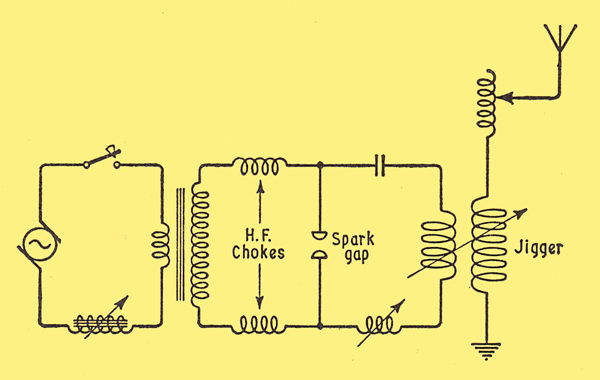
Basic circuit of a spark transmitter
For telegraphy, spark transmitters were almost universal. A big station of the period was an impressive affair; the sight, and still more the sound, of tens of kilowatts being dissipated in a crashing oscillatory discharge was something not easily forgotten. There was even a strong characteristic smell, generally referred to as 'ozone'. All the so-called 'systems' were basically similar; the circuit arrangement, shown in the accompanying diagram, was simple enough. The AC supply, of 50 or 60Hz, was stepped up to 15 or 20kV, an iron-cored choke being inserted in the transformer primary circuit to bring it into resonance with the alternator frequency. The condenser of the closed oscillatory circuit, charged through protective HF chokes, discharged itself through a spark gap, the electrodes of which, in all but the most up-to-date sets, were stationary, though adjustable as to distance. The closed circuit was coupled to the open aerial through a double-wound 'jigger' or an auto-transformer.
These fixed-gap sets gave a low-pitched, irregular tone distinguishable with difficulty from atmospherics and radiated heavily-damped wave trains, due to interaction between closed and aerial circuits. The 'rotary discharger' sets which were just being introduced were a great improvement in both these respects. In the most highly developed form the rotary electrode, mounted on an extension of the alternator shaft, carried a number of projecting studs arranged to give a spark for each half-cycle of the supply frequency; this had now been increased to several hundred cycles per second. Thus a clear high-pitched note was produced, and, as the primary circuit was opened after a very short interval of time, interaction was reduced and there were more persistent oscillations in the aerial circuit.
Transmitters fed from alternators were known as 'power sets' and were mostly fairly up-to-date. But there were in 1911 many relics of the not-so-distant past with induction coils drawing their supply from accumulators or DC mains. These were mostly fitted in merchant ships but the British Post Office station at Malin Head in the remote North-West of Ireland is thought to have had at this time a coil set worked from an accumulator battery charged from banks of primary cells.
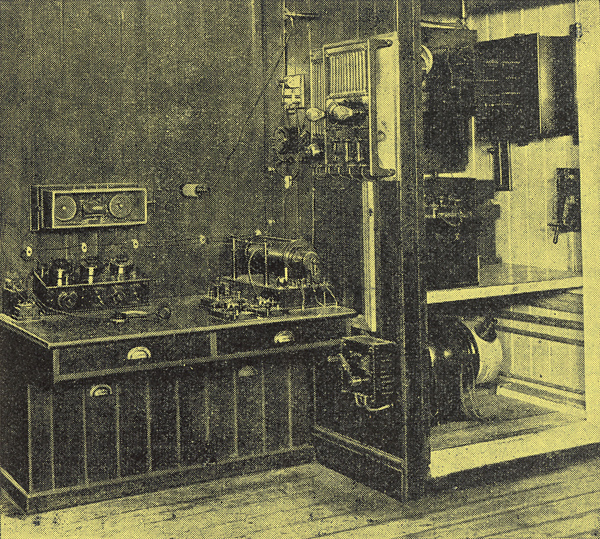
Typical Marconi ship's wireless installation of the period. (left) receiving tuner with magnetic detector on bulkhead above it; (centre) emergency spark-coil transmitter and (right) 1.5 kW rotary converter and spark gap of the main transmitter with (above) boxed coils of 'jigger' and aerial tuning inductances
Input power of the typical and more modern transmitters of the period for ships and coastal stations was generally between one and three kilowatts; anything more was considered high power. A fair number of point-to-point and special-service stations used as much as 30kW; anything more was quite exceptional. The lower-powered stations seldom achieved a daylight range of much over 300 miles, depending on their aerial height.
The most common type of receiver used the Marconi magnetic detector, a rugged and reliable but relatively rather insensitive device. It depended for its action on hysteresis changes in an endless soft-iron-wire band moved by clockwork through a coil carrying the received signal current. A magnetic field was provided by a pair of permanent magnets and a secondary winding, concentric with the EF coil, was connected to a pair of telephones. Unlike other detectors, the magnetic was a current-operated device and the associated three-circuit tuner had circuits with a low L/C ratio.
The only other kind of detector in widespread use was the crystal rectifier, the combinations most favoured being carborundum-steel, zincite-bomite and silicon-gold. Crystals were almost always used with two-circuit tuners having variable coupling between primary and secondary. A few stations had Fleming diodes.
Work on rotary RF generators had been going on for some years, but they had barely reached the stage of commercial use. The fact that an electric arc, shunted by a tuned circuit, could produce continuous oscillations had been known for some time. This had been turned to practical use by enclosing the arc in a chamber filled with hydrogen or alcohol vapour and subjecting it to a strong magnetic field. A small number of arc stations were in operation, mostly in America, but efficiency was low and continuous waves had little advantage until heterodyne reception became possible. The mechanical interrupters ('tickers') used in early CW receivers did not allow aural discrimination between signals and atmospherics.
Constructionally, the gear of the period tended to follow contemporary scientific instrument practice, with lacquered brass-work much in evidence, especially in Britain. Nickel-plated finish was more popular on the Continent and in the USA, where ceramic insulants tended to be more widely used. Ebonite was, however, the most favoured material; plastic mouldings were virtually unknown. The concept of a 'packaged' station had not arrived; the majority of transmitters and receivers consisted of a collection of units mounted where convenient and then wired together. But complete single-unit receivers were fairly common.
Some of the older stations used tinfoil-coated Leyden jars as transmitter condensers (the 'jar' still did occasional duty as a unit of capacitance, but not in our pages). There were more modem tubular versions with sputtered or electrically deposited metal coatings on superior glass. Oil-filled condensers with metal plates and sheet-glass dielectric were perhaps the most common. Receiving variable condensers often had ebonite dielectric.
By far the most important application of wireless was for marine use, both in merchant ships and the navies of the world. Next came coastal stations for working with the ships. These were often sited on prominent headlands; a relic of the days when ranges were even shorter than in 1911. A few strategic naval and military stations, mostly of relatively high power, had been erected.
With the exception of the transatlantic service (of which more later), wireless had so far made little progress in its competition with landline and cable for point-to-point work. There were, however, a certain number of stations providing a telegraph service for isolated communities in cases where a wire connection was uneconomic.
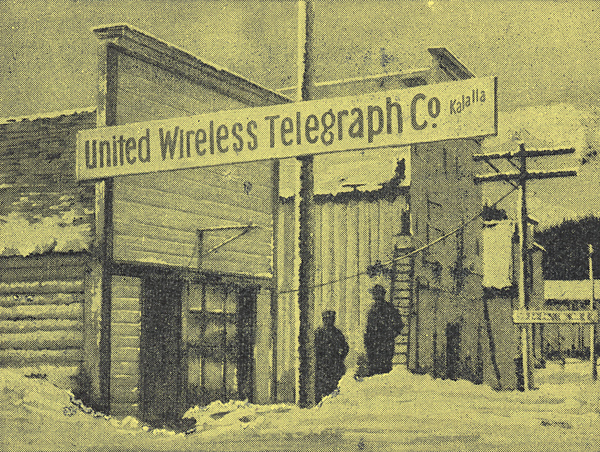
Log cabin station typical of those used by North American miners, trappers and fishermen to keep in touch with civilisation
In particular, the so-called log-cabin stations on the North American continent allowed local miners, trappers or fishermen to keep in touch with the outside world. A few of the early point-to-point stations, working at distances well beyond normal daylight range, provided a rather erratic service by taking advantage of night-time propagation conditions. Indeed, what might be called the 'Heaviside bonus' was extremely valuable in the early days, particularly to ships. With its help, extraordinary ranges were attained with some consistency, especially outside the equatorial atmospherics belt. Atmospherics, or X's, were the great enemy. X-stoppers, optimistically so-called, had already appeared, but no real solution was in sight. About the best that could be done was to use pairs of crystal detectors working in opposition as limiters.
Special-purpose equipment for a military and similar uses was already being designed and wireless had managed to stagger into the air in both lighter- and heavier-than-air machines.
Prominent among the handful of famous stations of the time was Poldhu, in Cornwall, whose main task, together with its counterpart Cape Cod, USA, was to provide a Press Service for the big liners which already printed daily newspapers on board. Poldhu was the first AC operated 'power set', as distinct from an instrument-maker's job powered from an induction coil. It had been used by Marconi just after the turn of the century for the first transatlantic experiments. Dr J A (afterwards Sir Ambrose) Fleming had been called in to do the original engineering design. Fleming is mainly remembered for his invention of the diode, but he has an equal - perhaps even greater - claim to fame as the first of the wireless engineers. Incidentally, he was the author of the first severely technical article (on RF resistance measurement) ever to be published in The Marconigraph.
The French military station on the Eiffel Tower, with its fixed spark gap and 25Hz AC supply ('one spark for a dot and three for a dash') was known throughout Europe for its time-signal service. Thanks to the exceptional height of aerial, very long ranges were achieved, though the signals were often quite difficult to read through X's. The German stations of Nauen and Norddeich were also well known. Most of the high-power transmitters worked on wavelengths around 2,000 metres but the transatlantic station Clifden and Glace Bay were on about 6,000m.
Commercially, the Marconi company and its associates throughout the world were in a dominant position, if only by virtue of the patent position. In our very first issue we reported a successful action for patent infringement against the British Radio Telegraph and Telephone Company which did much to consolidate that position. Marconi's personal claims as the originator of wireless telegraphy had been hotly challenged for a dozen years or more. But, now the smoke has cleared away, it is not difficult to see that those claims were fully justified. He may not have contributed any great fundamental invention but, put in the simplest possible way, he had 'made it work'. The last word in the controversy had in reality been said as long ago as 1897, when the Editor of the Electrical Review, in answer to the rhetorical question 'What did Marconi invent?' said, quite simply, 'the elevated electrode'. A prolonged subsequent correspondence in the pages of the journal failed to establish any valid claim to the anticipation of Marconi's invention of the aerial. It is clear enough now that an elevated aerial, plus an earth connection, was all that was basically necessary to turn Hertz's transmitting oscillator and Branly's receiving coherer at one step into a communication system with a useful beyond-the-horizon range. Subsequent detail improvements were not so difficult, but special credit should be given to Lodge, whose 'syntonic jars' experiment of 1889 had paved the way for syntony or tuning, without which wireless could never have got very far.
The race for priority had been close run and several rivals were breathing hard down Marconi's neck for the golden prize. And golden it turned out to be. When the young Marconi, in his early 20's, formed his company in 1897 he received £15,000-in golden sovereigns, not depreciated paper pounds and £60,000 in shares, which gave him a controlling interest. He was no guinea-pig director; at the time we began he was playing a dominant part in technical development.
At that time Marconi had no significant competition in England but his American company had to struggle against the United Wireless Company which controlled some 500 stations. But, in a year's time United Wireless was to be absorbed after admitting the validity of the Marconi patents. The real and most serious competitor, both commercially and technically, was the Telefunken Company in Germany, an amalgamation of several German wireless interests.
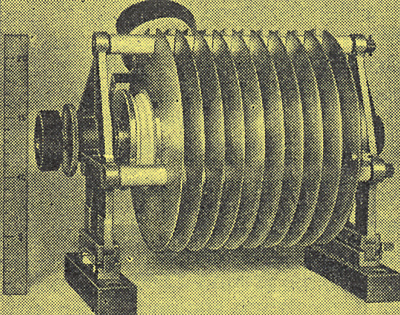
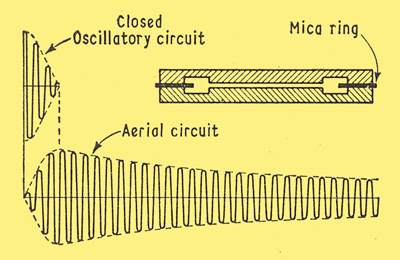
Construction and electrical characteristics of the Telefunken quenched spark gap.
Telefunken had produced a distinctive and extremely effective spark transmitter of which the main feature was a multiple spark gap made up of a number of silver-faced copper discs with deep cooling flanges separated by thin mica rings. In the standard 2.5kW set there were eight series-connected gaps. Thanks to the rapid dissipation of heat, excellent quenching of the primary circuit oscillations was secured, with wave-trains of high persistence in the aerial circuit. An alternator frequency of 500Hz gave a spark frequency of 1,000Hz the high-pitched note of Telefunken transmitters was quite distinctive. Efficiency was high, probably over 60%.
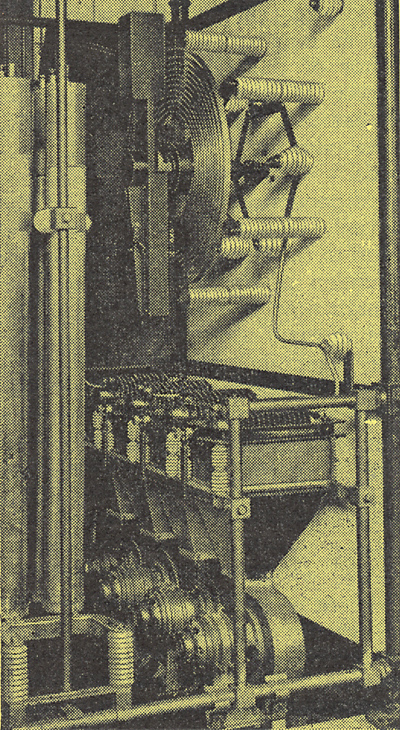
Air blast cooling of multiple quenched spark gaps in a Telefunken high-powered transmitter
The Telefunken receiver had a tuned aerial circuit variably coupled to a semi-aperiodic secondary shunted by a crystal detector and headphones. An alternative type of set, giving higher selectivity, had an intermediate tuned circuit. Clip-in interchangeable coils were used. The detector, a sealed cartridge usually with a silicon-gold combination, was interesting as a kind of forerunner of the modern crystal diode.
Germany's contribution to wireless development had been acknowledged when Ferdinand Braun shared with Marconi the Nobel Prize for physics in 1909.
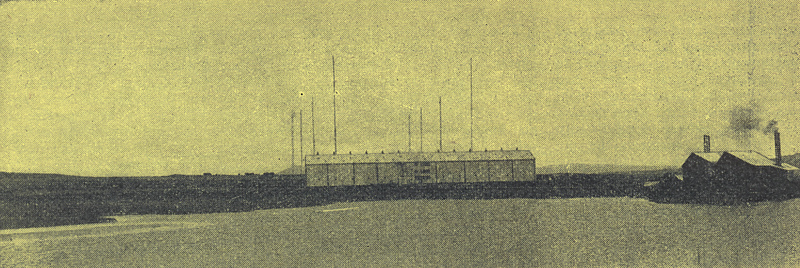
General view of the transatlantic high-power spark station at Cliften, Connemara. On the right is the peat-burning power house
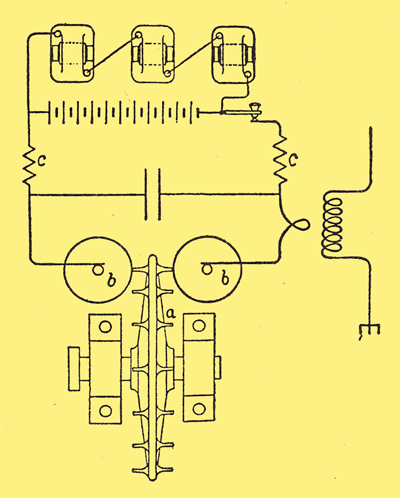
Circuit diagram of the Clifden 'dc' transmitter
In the early days the transatlantic station at Clifden, in the wilds of Connemara, was the wonder of the world of wireless. And rightly so; there was nothing remotely approaching it, either in technology or performance, except its communicating station at Glace Bay, Nova Scotia, which, being more remote, was less in the limelight. Marconi himself gave a detailed description of Clifden, which had recently been rebuilt, in a lecture to the Royal Institution, reported in our first volume. This fantastic station was unique in being powered by DC, drawing 300kW from a 6,000-cell accumulator battery, 'the largest of its kind in existence', which, when fully charged, gave a voltage of 15,000. Charging of the battery was by three series-connected high-voltage generators, the prime mover being a steam engine. The six boilers were fired with peat, brought by a light railway from the adjacent bog. Still more fantastic was the closed circuit air-dielectric condenser; the metal plates were spaced a foot apart and this component - the first to which the term 'low-loss' was applied - needed an enormous shed to house it. The rotary spark gap was run at a speed giving a sparking rate of 500 per second. As the rate was independent of load, the note was exceptionally pure.
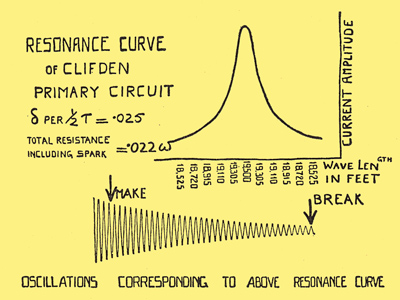

Characteristics of the Clifden transmitter.
For the year to April, 1911, it was proudly claimed that 812,200 words of paid traffic had been pumped across the Atlantic. That would sound pitifully small to the manager of a modern communication circuit, but was probably a great improvement over that achieved with earlier apparatus. Detailed records are lacking, but in the Marconi archives there are some figures relating to the period beginning October, 1907, when a limited public service had been opened. Traffic was then running at the rate of a mere 300,000 words a year and average delays ranged from 2.5 hours at best to over 14 hours. And - supreme humiliation to wireless men - wwell over 7,000 words had to be handed over for transmission by cable. Apart from the humiliation, that involved a dead financial loss of 4d a word: the 'via Marconi' service was cut-price.
We do not know what were the delays and 'cablings', as they were called, in 1910/11, but it seems certain that the new apparatus just described had brought about a great improvement in communication. Independent testimony given a year or two later suggested that average delays did not exceed those of the cable. But highly detailed signal-strength curves shown in Marconi's 1911 lecture make it appear that communication was liable to fail for a few hours nightly at times when X's were prevalent. Still, it is fair to say the Atlantic had been conquered at last after many failures and disappointments. The epic struggle to get consistent signals across had started from the Canadian end (The Canadian government had subsidized the Glace Bay station to the extent of $80,000.) eight years earlier, at a time when nothing was known about long-distance propagation; the engineers did not even know on what wavelength they were transmitting! Countless changes in circuitry, power and aerial arrangement had been made. Glace Bay station had even been shifted to a different site.
Clifden came to a sad end in 'The Troubles' of 1922, when the station buildings were burned to the ground. Still, it had nearly served its time and a radically new long-distance technique was soon to emerge. The station has no memorial, though, by a strange coincidence, near the site is a commemoration stone to the flyers Alcock and Brown, who crash-landed there after conquering the Atlantic through a different medium.
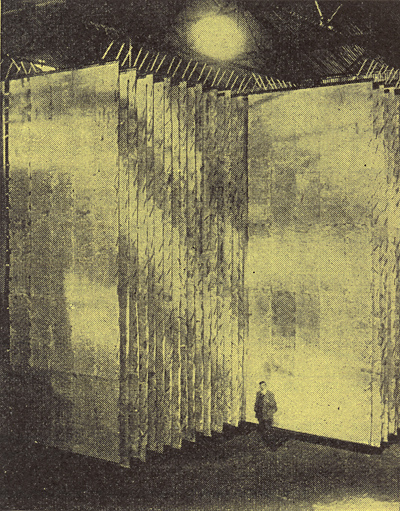
Air-dieletric condenser of the closed circuit at Cliftden
|